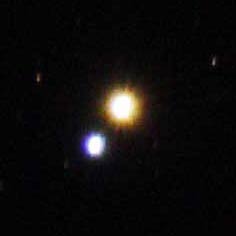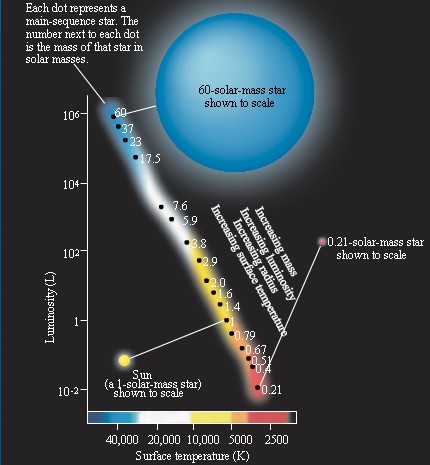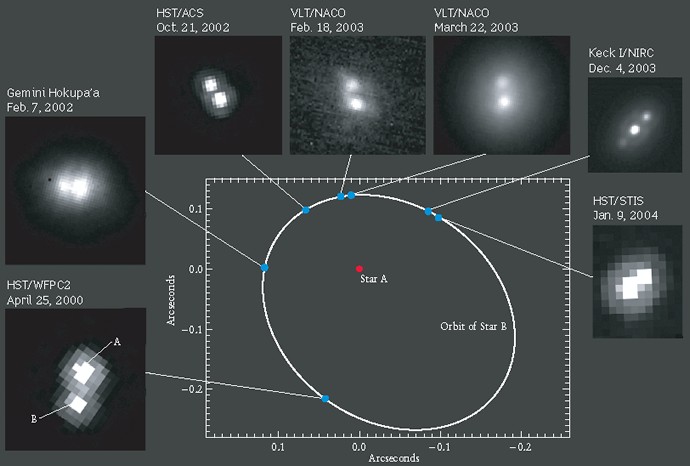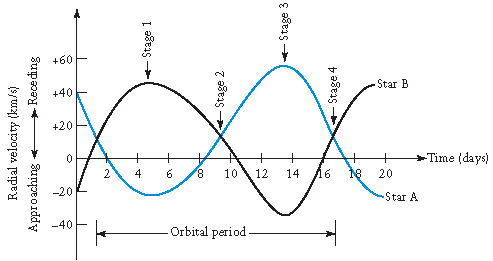Chapter 17. Determining Stellar Masses
17.1 Introduction

Author: Scott Miller, Penn State University
Editor: Grace L. Deming, University of Maryland

The goals of this module: After completing this exercise, you should be able to:
- Describe how two stars orbit around one another and explain how to determine the ratio of their masses.
- Describe the various types of binary systems and explain how we can measure various properties of the stars in order to calculate their masses.
- Explain why there are some limitations to determining the masses of stars in a binary system.
In this module you will explore:
- The orbits of two stars gravitationally bound to one another
- The different types of binary systems
- How we observe binaries to determine their orbital periods and the orbital sizes
Why you are doing it: Mass is one of the most important properties of a star, and yet the most difficult to determine for a solitary star. Astronomers can only determine masses for stars which form in pairs (like the binary star Albireo shown above) or groups of stars. Once we can determine the mass of a star, though, we can determine so much more about it.
17.2 Background

Mass is one of the most important properties of a star. It turns out that stellar mass has an effect on so many other properties. That is because objects with mass exert gravitational forces, and therefore the mass of a star is directly related to the amount of gravity it has to pull itself together, generate energy, maintain its size, and live its life. Because of this, astronomers are very interested in determining the masses of stars.
So how can we determine the mass of a star? In order to determine a star's mass, you need to find out how it gravitationally influences other objects. While it appears that most stars form with planets around them, the planets are generally too dim compared to their parent stars to directly observe. Therefore, we cannot see how stars affect their planets' motions.
It turns out, though, that not all stars are solitary like our Sun. Roughly one-half of all stars have at least one stellar companion. If a star exists in a binary system, then we can observe how each star gravitationally influences its companion.
Question 17.1
M8FQeKXLRWdR0u2Jbpx/eQPc2AnhhI3OSharrM95LZcXSJuEtb2KG7YkBMG3m7FBi4Dbe9JhJhrHXin0lQU6/W7/mbzOk7R9vDRtyE7kwohOIEbn+jjwA6MS6YXANdHheYhjnGTPbMuAC6dn7buiUg+CLepfvNFVjNFZwlbi2nCGHNVep17//cgFoWTb0TUVH4EDVO8S+Hq/Tsp+rKvlLIqdzkyu3yccrhtUgy6OYcVPrQUBb7Vte/NIZXWbrOIVtop2uMJHjNQwy7L55H0Bt9DoQGY=17.3 The Orbits of Binary Stars
So how do we determine the masses of the stars in a binary system? It turns out to be a two-step process:
When you have two stars of comparable mass in a binary system, one doesn't orbit around the other, but instead they both orbit around a common center of mass. If the two stars have exactly the same mass, then the center of mass lies directly half way between the two stars. If the stars are of unequal mass, then the center of mass lies closer to the more massive object. It turns out that the ratio of distances (r) of the two stars is inversely related to the ratio of masses (M) of the two stars (stars A and B). We can write this as:
rA/rB = MB/MA
Therefore, if we can observe the two stars as they orbit and determine their distances from the center of mass, then we can determine the ratio of their masses.
To observe orbital motion of stars around the center of mass, click on play.

Question 17.2
+eWwEcPbQ1YTD9lASdaN3XESg0BDG0kG/r+aEImRyicSRoNRsOWMTLnbbCOkH+IL2o9RnI7xsafHdHhi6+26ynqrlOOcQrqmBw+kJ9kvbF1aM+iiemFOeio6ksfKUaQibLFnIjeQ4Ljoht+7a/f8kFLBI3/KBprC9c2rURCkbGuBPLh7l5URdfIW53AnBl9hPW6ZeFMfvvr1CtIw6a3SGbssuE3GWzsa+KCUYUW4QezZJD/fSummary
In addition, we can also get the ratio of velocities of the two stars from the spectrum, which will come in handy later. As the two stars orbit around their common center of mass, they take the same amount of time to complete one orbit, yet the more massive star, which is closer to the center of mass, has less distance to travel than the less massive star. Because of this, we can determine a relationship between the ratio of masses and the ratio of velocities (v) for the stars (A and B), which can be written as:
MA/MB = vB/vA
The more massive object moves slower than the less massive object.
17.4 Visual Binaries
Knowing the ratio of the masses is not enough. We'd like to know each star's individual mass. To do so, we need more information. When Isaac Newton developed his theory of universal gravitation, he realized that objects orbit around one another due to the fact that they have mass, and objects of mass exert gravitational forces. He used his knowledge to develop a generalized version of Kepler's third law of planetary motion. According to Newton's version of this law, the cube of the average distance (a) between the two orbiting objects, divided by the square of the period (p) of their orbits, is equal to the sum of their masses (M). This can be written as:
a3/P2 = (M1 + M2)
Using this equation, if we can measure the average separation between the two stars and the amount of time they take to orbit each other once, we can determine the sum of their masses. If we know the sum of their masses and the ratio of their masses, then we can determine their individual masses.

In some binary systems, we are actually able to observe both stars as they orbit around each other. These systems are called Visual Binaries. In the figure above, two stars are seen to orbit around each other (while the central diagram shows star B orbiting around star A, in actuality, they are both orbiting around their common center of mass). We don't need to observe an entire orbit in order to determine the orbits of the two stars; a fraction of the orbit is sufficient. By observing the stars over time and knowing how far away they are, we can determine the period of their orbit, their average distance of separation, and their relative distances from the center of mass. As described on the previous page, with this information, we can determine each star's mass. If the average distance of separation (a) is measured in Astronomical Units (AU) and the orbit period (P) is measured in years, then the masses will be calculated in units of solar masses (M\(\odot\)).
Question 17.3
pwsk4e9sYHZqZWu8D2mTb+5fuGlcfN/Kqbkil8L1ChZuMecoxjaVx2yv22bjJtWcjRDFqerH4gJ3CEAfH38HT8mS59Z4qlnvNj0Tf8cQvOi1jRr9i5j+aLa21yT+KqT6Ufwyqcsm3tO9DmL6wEK6wEHSUU6oGkLBI9g0OWeOAl8Q2fglTwv4tUtgtsS8a85P2x3K984G5z33S/TxOwpeKU01vh090ptVe4NxFIIIZ08nPuHJZPmFVfBptWXTaBobUbpXGdbhZFjS3g8emg5zLWcegSyaOT8CUyD7oXNDAS4U9uAfTpf6A/KOufs=17.5 Spectroscopic Binaries
Unfortunately, it is not possible to resolve every binary system. In many cases, even through the best telescopes, binary stars may appear as one object, rather than as two distinct stars. It is still possible to determine that there are two stars present, though. If we observe the light coming from a binary system, we may find, if both stars are bright enough, two sets of spectroscopic lines, indicating the presence of two stars in orbit around each other.
As the two stars orbit around each other, they orbit within a two-dimensional plane. This plane of orbit will be randomly inclined to our line of sight. It might not be inclined at all (which corresponds to an inclination of 0°), in which case the two stars would always remain the same distance away from us. The other extreme could be that the plane of orbit is completely inclined to our line of sight (an inclination of 90°). In this case, if we could see the orbits we would be presented with an edge-on view of them. In general, the orbits of the stars will be inclined at some angle between these two, and the exact angle of inclination is difficult to determine.
As long as the plane of orbit is inclined at some angle at all, the stars, as they move through their elliptical orbits, will sometimes move towards us and sometimes move away from us. We can measure this radial motion through the Doppler Effect. As we look at the spectra of one or both of the stars, we will see their spectral lines shift over time; shifted to bluer wavelengths when a star is moving towards us, and shifted to redder wavelengths when a star is moving away from us.

Click on Play to begin the animation. In this case, we can detect sufficient light from both stars to determine their spectra. See how, as we observe over time, their spectral lines shift back and forth, as the star moves towards and away from us. By observing this, we can determine the masses of the stars. Here's how:
First, we can determine their period of orbit as the amount of time it takes the spectral patterns to shift back and forth. This is just the amount of time it takes for the stars to complete one full orbit. Second, we can determine the velocities of the stars when they are moving towards or away from us by how much their wavelengths are shifted due to the Doppler Effect. Third, if we know the period of time the stars orbit once and how fast they travel, we can determine the sizes of their orbit.
Question 17.4
SgK/8amsttkmUhFCecGunf44H7z7Him3PxkT1ZFDG9Am9gayXOvH7hXtSQ8yp5HuZ4aVnDFhy3vvZW2ZVzfLjlAXsnloVD+44P73YMFmurk4Xf5CQgFiBQ13f36CRDOI3QTePQNm6XD2UM1ViDzp9FDz+oNrECXr3WR22HTKmpK7Y/tqfEbk0U6ECTCLzPCplO5vLngThjbar0MsvTIq7MXhLz056Y6TV4IFdCreNd/yBJqZGvEnPjt6HLRUOaJGHRao7tUwd0UKjRibmZgREN7huHorBXzXLW3bhQZavsEkWvdHIgr68jVZc8wgikI782SNTWj/OKOaLnrfCjgV+p1ML/Znm2pE3woozkrhDaB3BBlbwG2EDx9ZJZv4wc7K4LlApPx6NU3R8HmqFn7mdz2FQlfLxGGaC26BKCXxuoZL9R4F3J/kIAkXw1PIo66EYp+uLEPMXiDaDHJxSLiQreti5SCDzUHCn5xp4GpfcqjX1Nt34wlnEI3Q83sKFXgc9s/gbe79SKLO/9B5f8DN/EbcK5RfLJzqb8WS+7mWg0c2BfIwdJH+kWa9tZyWK8NgwbUkWQHh4UhM9pm42mdH3u4lCOzcu7m+HdCNlnbq53F3cAa8QRvJ/kXEMvtR9wq+lB2hXXg5eTsUxtZZG0w5F27F8SLv/bgoYLFN9GDKA6qE1Aw8HUEQt94lEIoSE48fc2UcnYqoxRhlcGzTWRetIS4yQCaB6ajEfo8GI34b4pyACtXYL0NXb79jKKI0LDmCMm1Gkrej+Gd1Ys7foKsyEdfLFrv8TCmp17.6 Limitations of Spectroscopic Binaries

Knowing the size and period of the orbit, we can use Newton's modified version of Kepler's third law to determine the sum of the masses of the stars. Knowing the ratio of their velocities gives us the ratio of their masses. With this, we can determine the individual masses of the stars.
Unfortunately, though, there is one problem. The Doppler Effect only gives us radial motion; motion towards or away from us. Spectroscopic binary systems are randomly inclined to us, and so we can detect only the radial component of their velocities. Since in a spectroscopic binary system the two stars appear as only one star (even when viewed through the best telescopes), we cannot observe them orbiting around each other, and it is nearly impossible to determine the inclination of their orbits. Without the inclination the value we get for velocity is a lower limit, which means this is the lowest possible value, but the true value may be higher. A lower limit on velocities gives a lower limit of the stars' masses.
Another problem is that sometimes one of the stars isn't bright enough for us to detect its light. We can still determine that we are looking at a spectroscopic binary system because the spectral lines of the bright star still shift back and forth, but without the spectral lines of the other star, we cannot determine the ratio of velocities, and therefore cannot determine the ratio of masses of the two stars. In this case, we get an incomplete picture of the masses of the two stars.
17.7 Eclipsing Binaries
Sometimes we get lucky, and the plane of orbit of the two stars is oriented along our line of sight, such that we can determine the inclination of their orbit. How do we determine this? When the inclination is near 90°, then as the two stars periodically orbit around one another, every so often one star will pass in front of the other, blocking the light of the background star. We call these binary systems Eclipsing Binaries, because one star is being eclipsed by the other. How can we use this to our advantage?

To see how, watch the animation above. We can plot the light curve for the binary system. A light curve is simply a plot of the total light we receive from the stars as a function of time. When neither star is eclipsed, then we receive the total amount of light from both stars. But when one star passes in front of the other, then the total amount of light we receive is diminished, as one star blocks light from the other star.
So how do we determine the masses of the stars from this information? The period of orbit of the two stars is simply the amount of time it takes the light curve to repeat itself. We can observe the two stars periodically, plot the total amount of light we receive from them over time and determine how long it take the pattern to repeat itself. The velocities of the stars can be determined through spectroscopic analysis of the Doppler shift of their light, as we did previously. Only this time, because we know that we are observing an eclipsing binary, we know that the inclination of the orbital plane is near 90°. When we observe the maximum Doppler shift, we are measuring the stars' true velocity. Once we know the period and velocities of the stars, we can determine the sizes of their orbits. Then we can use Newton's modified version of Kepler's third law, along with the ratio of masses of the two stars, to give us their actual masses.
Question 17.5
EDVgwiFDKJvO00uLs/8cmtZA0fLvMmVYieM45O6vTOzrBXTEHHih1IuuYUgJDBts7lxg4zi43aTSqBOl42Dkp624azFYeFBqofzBaqtdXEKkBEnfMvwtoLp1GDzJiNhkXHOpg92iBvHepJvDI12h08odHQ8+j5fhVDPE10mdFUUt+gp2l0pYQb8Ifr+kkwy1S5hUkEZxCO7LLudBGLLnFMORqy9782CCH5HmkcCiKXFMPAR5jMlFwrhXunZRCNV3rltXnnFnmSuWaMcc2w3f9SeXP/an/V0MYa+OOcHLt353tm2h7rfwk6SFRI0=Summary
As you can see, by observing how the gravitational forces exerted between two stars in a binary system affect the period of orbit and average distance of separation, astronomers can determine their masses. As you will find out later, this is one of the most important properties of a star, and directly influences many other stellar properties, such as luminosity, temperature, size and lifetime. It is the mass of a star which controls everything!
17.8 Quick Check Quiz
Indepth Activity: Determining Stellar Masses